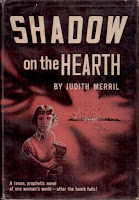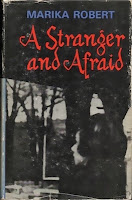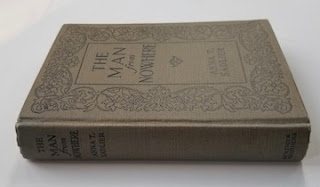Nobody told me there'd be days like these. The Nazis in the bathroom just below the stairs are the least of my worries.
I've been spending this time of self-isolation out and about in my role as an essential worker. On days off, I wander about the woods of our secluded home gathering firewood for next fall and winter. I sometimes fear I'm turning into the Michael Caine character in The Children of Men.
The Children of Men is not be the thing to watch just now. I managed to make it through the first episode of HBO's The Plot Against America, but could take no more. Since then, it's been SCTV and old episodes of 30 Rock.
I'm in need of a good laugh these days, though I well understand the curiosity of those who've asked me to recommend Canadian novels dealing with pandemics.
The craziest by far is May Agnes Fleming's The Midnight Queen (1863), which is set in London during the Great Plague. In Tom Ardies' Pandemic (1973), part-time secret agent Charlie Sparrow combats a millionaire who looks to unleash a killer virus upon the world.
But my greatest recommendation is The Last Canadian (1974) by William C. Heine, which just happens to be the first Canadian novel I ever read. Ten years ago, I shared my thoughts about the work in a blog post, which was subsequently taken down and reworked for inclusion in The Dusty Bookcase — the book.
I'm bringing it back for the curious. Enjoy... then look for something funny.
AT LONG LAST LUNACY

The Last Canadian
William C. Heine
Markham, ON: Pocket Books, 1974
253 pages
In the opening chapter of The Last Canadian, protagonist Gene Arnprior leaves his suburban home and speeds along the Trans-Canada toward Montreal. A to B, it's not much of a scene, but the image has remained with me since I read this book at age twelve. The novel was the first in which I encountered a familiar landscape. Of the rest, I remembered nothing... nothing of the sexism, the crazed politics or the absurdity.
Penned by the editor-in-chief of the London Free Press, it begins with late night news bulletins about mysterious deaths in Colorado. Gene recognizes what others don't and takes to the air, flying his wife and two sons to a remote fishing camp near James Bay. As a virus sweeps through the Americas, killing nearly everyone, the Arnprior family live untouched for three idyllic years, before coming into contact with a carrier. As it turns out, what doesn't kill you makes you stronger... Gene lives on, but must bury his wife and children.
The Last Canadian is a favourite of survivalists everywhere. Someone calling himself Wolverine writes on the Survivalist Blog:
The immediate response reaction is instructive. Second there are the North country survival techniques. Third there are psychological factors of being a survivor in a situation where most others die. And there is more, dealing with post-disaster situations, though I won't go into that because it would spoil the book for you.
I won't be as courteous. Spoilers will follow, but first this complaint: the title is a cheat. Gene is not "The Last Canadian" – there are plenty of others – rather he considers himself such because his citizenship papers came through the day before the plague struck. Gene is an American who came north for work. He'd enjoyed his time in Canada, had made many friends and "had come to understand the Canadian parliamentary system, and agreed that it was far more flexible and effective than the rigidity of the American system of divided constitutional responsibility."
Reason before passion.
Is it then surprising that, there being no parliament, he's drawn back to the United States? Heading south, Gene resists all invitations of the Canadians he meets, whom he considers "eccentric" because they've chosen to stay put, supporting themselves through farming and whatever might be found in local shops. There's much more excitement to be found south of the border.
First, he stumbles into a Manhattan turf war – but that's hardly worth mentioning. As a carrier, Gene inadvertently kills a number of Soviet military types who have set up a base in Florida. In doing so, he becomes Enemy #1 of the USSR. They send frogmen assassins, set off bombs, plant land mines, and lob nuclear missiles in his general direction, but still Gene beetles on. When a Soviet submarine destroys his Chesapeake Bay home, killing the woman he considers his new wife, Gene seeks revenge.
Though he has no evidence, Gene comes to blame the Soviets for the plague (in fact, it's a rogue Russian scientist), and dedicates himself to infecting the USSR. He begins with a short wave radio broadcast directed at the Kremlin: "If the Russian people were half as smart as your literature says they are, they'd have tossed you out long ago. Because they haven't, I have to assume they're as stupid as you are."
You see, because they are stupid, Gene has decided that all citizens of the Soviet Union should die. He cares not one bit that the plague will spread beyond the borders of the country, killing the rest of Asia and Europe, never mind Africa.
It's all crazy, but the reader is not surprised. Though Heine spills an awful lot of primary colours in an effort to paint the man as a hero, concern has been growing for quite some time. Remember when he hit his wife, just so she'd understand the gravity of their situation? How about when he'd threatened to tie his young son to a tree and whip him until he couldn't stand – all because he'd fallen asleep while tending a fire? Then there's that little glimpse of Gene's psyche provided when his new love, Leila, tells him a horrific story of being kidnapped, beaten and raped repeatedly by a psychopath:
"You can't imagine the things he made me do. And he killed a man to get one of his girls."Gene felt another chuckle welling up. In the few years he'd spent in Korea and Japan, he'd read about most of the sex things there were to do, and tried a few himself. He stifled it, however, recognizing her revulsion.
Yep, pretty funny stuff... and don't forget to add that boys will be boys.
Intent on killing billions, Gene makes his way up the Pacific Coast, dodging Soviet and American forces, before crossing the Bering Strait into the USSR. Hundreds of Americans and an untold number of Russians die as a result. His journey and life are finally ended by a clusterfuck of nuclear strikes – Soviet, Chinese, American and British – which obliterate the Anadyr basin.
Lest the reader agree with the Soviets that Gene had become a madman, Heine is at the ready to set things right. You see, Gene's actions were perfectly understandable; the British prime minister tells us so.
We're left with the image of radioactive clouds composed of the people and terrain of Anadyr. They drift across Canada, sprinkling poisoned dust over the land. Some settles on the graves of Gene's wife and children:
In time the rains washed the radioactive dust down among the rocks and deep into the soil.Something of Eugene Arnprior, who had suffered much and had done more to serve mankind than he could ever have imagined, had come home to be with those he loved.
Thus ends what I believe to be the stupidest Canadian novel.
Trivia: Published in the US under the snicker-inducing title Death Wind, and later as – go figure – The Last American.
Terrifying, either way.
In 1998, the novel was transformed into a Steven Seagal vehicle titled The Patriot. Here the action hero plays Dr Wesley McClaren, a small town immunologist doing battle with Montana militiamen and the lethal virus they've released. Sure sounds like Gene Arnprior could help out, but he's nowhere to be found. Maybe he's up on Parliament Hill taking in the House of Commons. Who knows. The Dominion to the north is never mentioned, nor is the Soviet Union, for that matter. Truth be told, The Patriot has as much to do with the novel as it does good cinema.
It can be seen, in its entirety, on YouTube:
Terrifying, either way.
In 1998, the novel was transformed into a Steven Seagal vehicle titled The Patriot. Here the action hero plays Dr Wesley McClaren, a small town immunologist doing battle with Montana militiamen and the lethal virus they've released. Sure sounds like Gene Arnprior could help out, but he's nowhere to be found. Maybe he's up on Parliament Hill taking in the House of Commons. Who knows. The Dominion to the north is never mentioned, nor is the Soviet Union, for that matter. Truth be told, The Patriot has as much to do with the novel as it does good cinema.
It can be seen, in its entirety, on YouTube:
Object: A typical mass market paperback. The cover photo is by Jock Carroll, who also served as editor of this and other paperback originals published by the Pocket Books imprint. The final pages advertise more desirable titles in the series, including:
FESTIVAL by Bryan Hay. A modern novel which reveals the rip-off of drug-crazy kids by music festival promoters.THE QUEERS OF NEW YORK by Leo Orenstein. A novel of the homosexual underground.THE HAPPY HAIRDRESSER by Nicholas Loupos. A rollicking revelation of what Canadian women do and say when they let their hair down.
Access: As far as I've been able to determine, The Last Canadian went through at least seven printings, making its scarcity in the used book market something of a mystery. Just two copies are currently listed online. At US$99.95 and US$133.53, both are described as being in crummy condition.
Where do these survivalists get their money?
Take heart, April is less than four days away. The President of the United States has assured us that the virus will be gone by then. Something to do with the heat, he says.
Strange days indeed.
Where do these survivalists get their money?
Take heart, April is less than four days away. The President of the United States has assured us that the virus will be gone by then. Something to do with the heat, he says.
Strange days indeed.




























